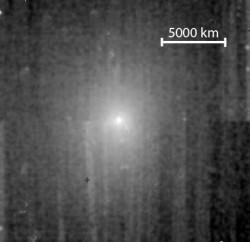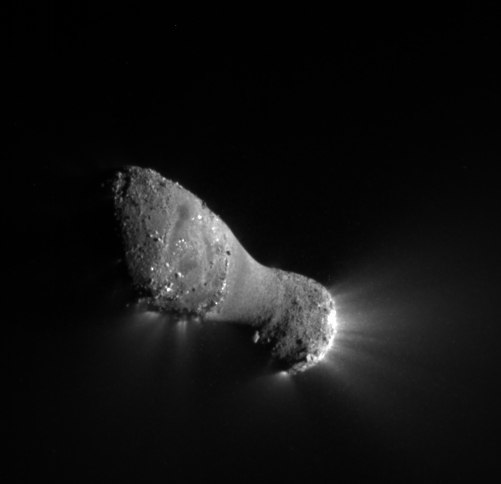[/caption]
No, EPOXI isn’t the name of a new super glue, but an abbreviation for the continuation of Deep Impact. While the original mission to study Comet 9P/Tempel was a huge success, the spacecraft continues to explore objects of opportunity. Its name is derived from Extrasolar Planet Observations and Characterization (EPOCh) and the Deep Impact Extended Investigation (DIXI)… and it’s now fulfilling another goal as it swings by Comet Hartley 2. It approached, encountered and departed, sending back 117,000 images and spectral findings – along with some surprising observations.
“From all the imaging we took during approach, we knew the comet was a little skittish even before flyby,” said EPOXI Project Manager Tim Larson of NASA’s Jet Propulsion Laboratory in Pasadena, Calif. “It was moving around the sky like a knuckleball and gave my navigators fits, and these new results show this little comet is downright hyperactive.”
What EPOXI found was a “hyperactive comet” – one that didn’t react in anticipated ways. From a distance of 431 miles (694 kilometers), the spacecraft watched as water and carbon-dioxide jets erupted from the flying space rock’s surface. While this in itself isn’t unusual, the fact that it didn’t happen uniformly caused scientists to sit up and take notice. Jets occurred at both ends of the comet with the strongest activity centered on the small end. Water vapor ejected from the central portion showed a notable lack of carbon-dioxide and ice, leading investigators to speculate the material was re-deposited from the ends of Hartley 2.
“Hartley 2 is a hyperactive little comet, spewing out more water than most other comets its size,” said Mike A’Hearn, principal investigator of EPOXI from the University of Maryland, College Park. “When warmed by the sun, dry ice — frozen carbon dioxide — deep in the comet’s body turns to gas jetting off the comet and dragging water ice with it.”

What makes this new class of comets so unusual? Just three ingredients: deposits around the inactive center which may have originated at the ends, a tumbling state of rotation and a large end containing ubiquitous inclusions which can span`approximately 165 feet (50 meters) high and 260 feet (80 meters) wide. EPOXI also picked up another surprise at Hartley 2’s smaller end – shiny cubicals reaching 16 stories tall and two to three times more reflective than other average surface materials. But that’s not all. For nine days in September, the energetic comet expelled 10 million times more CN gas in its coma – a dramatic and unexpected change called the “CN anomaly”. It was analyzed by McFadden and Dennis Bodewits, a former postdoctoral fellow at NASA Goddard who is now at the University of Maryland, and their colleagues. This comet exhaust normally includes a similar amount of dust, but not in this case.
“We aren’t sure why this dramatic change happened,” says McFadden. “We know that Hartley 2 gives off considerably more CN gas than comet Tempel 1, which was studied earlier by a probe released by the Deep Impact spacecraft. But we don’t know why Hartley 2 has more CN, and we don’t know why the amount coming off the comet changed so drastically for a short period of time. We’ve never seen anything like this before.”
Until now…
Original Story Source: NASA Mission News.


If you look at the comets that spacecraft have visited, one thing is clear. They’re all different. We’re unlikely to have visited all of the types of comets that there are.
Yo Tammy, there’s a double “a” in the last sentence of the sixth paragraph.
🙂
Look folks, just a jest here. CN = chloracetophenone = one of several types of tear gas
This indicated, to me at least, that the comet felt the need to use tear gas on some as yet unknown assailant. I can see the commercial now… followed up by a PSA (Public Service Announcement).
Live is hard when your orbit is through some zones. It pays to be protected, it pays to be prepared, when your comet is on the line use HA brand CN, that’s right folks, it is Hyperactive for YOU!
Anyone having knowledge of the perpetuation of any space crime within the jurisdictional zones of this authority please notify the SCIBB (Space Crime Investigatory Board & Bureau) with immediateness.
Mary
I would like to file a report! There was an unknown mass that tried to shake me down.
It’s a bowling pin, not a doughnut. I think you confuse the wise guys for the porker.
Which may come to the same result in the protection racket, natch.
Uh oh. A comet with ADHD. Gonna get me some anxiety symptoms now.
Btw, some Q’s on the A’s:
But wasn’t the rumor that the name was chosen precisely because the mission choose to “stick around”? Explaining the “coincidence”.
That is very specific. Is all that, geometry and deposit detail, really observed for “a dozen comets”?